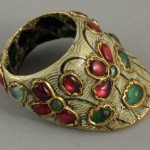To Facet or Not To Facet? That Is The Question
18k Gold and Lapis Lazuli Margaret Ring, Shop Now
Jewelry from The Royal Tombs of Ur. Gold and lapis lazuli necklace.
Necklace (kanthi), circa 1850-75, made of gold set with diamonds and emerald
Full Rose Cut aka Dutch Rose or Holland Rose
Pomellato Rouge Passion Earrings
JAR Joel Rosenthal
Seaman Schepps emerald, sapphire and diamond Cocktail Ring
18k Gold and Chrysophrase Margaret Ring. Shop Now
8k gold and cabochon amethyst “bunch of grapes” ring, David Webb, circa 1970s.
Verdura cabochon tourmaline and diamond brooch
“To regard the unusual configuration, texture, or coloring of a piece of stone or mineral crystal, to contemplate the possible alterations of a stone so as to wring from it the promise of greater beauty is to begin to understand the mysteries of lapidary.”
For many people, the term “jewelry” is synonymous with twinkling, sparkling gems. Diamonds catching the sun and tossing it back to our eyes. Precious stones hypnotizing us with intense shimmers of color. We use words like “Fire”, “Brilliance” and “Scintillation” to describe the way gemstones play with light– bewitching the viewer and making it impossible to look away.
While most gemstones occur in nature as attractive minerals, it is the act of cutting into and polishing these precious rocks that uncovers their flashier, more alluring nature. The history of gemstone use in jewelry is, in no small way, the story of the art and evolution of lapidary and it’s influence on jewelry designers.
In the beginning….way back in the beginning, as in about 100,000 years ago, humankind may have used flint tools to pierce holes in shells used as talismans or amulets (A talisman is a charm or other ornament that has a magical meaning to the wearer). It could ward off evil, disease or warrant good luck to the wearer. These shell beads are the earliest jewelry known to humankind.
As humankind progressed, so too did our ornamentation. The earliest recorded gold jewelry found in the tomb of Queen Zer and of Queen Pu-abi of Ur in Sumeria in the Third Millenium BC. includes beads of lapis and agate polished to a high gloss, most likely using water and grit made from harder stones. The “glyptic art” of the Ancient Greeks and Egyptians saw intricate carvings of humans, animals and anthropomorphic creatures worked into precious stones and then polished with a paste or buffing material. It is thought that a rudimentary type of gem cutting appeared in India c 2000BC, and that Indian artisans employed an early type of faceting as their skills developed.
The Sumerians, more than any other people in the world, loved lapis lazuli. For them, it represented fabulous wealth, literally and as well as figuratively. It is not indigenous to Sumer, and was mined in faraway Afghanistan. Because it had to be imported over vast distances, it was very expensive.
Jewelry from The Royal Tombs of Ur. Gold and lapis lazuli necklace.
Great advances in gem cutting can be attributed to the Islamic Period which saw the origination of the art of polyhedral faceting. The invention of the horizontally turning cutting wheel during the late 1400’s in Europe enabled European gem cutters to plot complicated geometric faceting schemes based in part upon the newly understood laws of optics and execute them with precision.
Thus the art of improving upon one of nature’s most beautiful creations has swung throughout history from basic polishing and economical cutting, possibly as a celebration of form and color and meant to preserve as much of the rare gem material as possible –-to more and more elaborate faceting employed as an attempt to display the color showcased within natural gemstones and to create maximum “fire” and ‘brilliance” while these stones reflected the light back to the lucky viewer.
Gemstones used to adorn jewelry within the ancient world may have been the product of the early cutting techniques employed by the artisans of their time, but their softly polished surfaces and smooth contours are much more than a pit stop along the evolutionary highway of lapidary. Indeed, stones cut “en cabochon”— the term comes from the French caboche, meaning knob or small dome–continue to be produced despite rapid advancements in the skill and technology behind the art of faceting. Why?
In some cases, the material itself possesses optical effects that can only be seen with the smoothly shaped and polished surface characteristic of a cabochon. Examples are gems that display optical phenomena such as asterism (the star effect), chatoyancy (the cat’s eye effect), and adularescence (moonstone’s unearthly glow). The highly prized asterism locked within certain rare rubies and sapphires is revealed only when a stone is cut en cabochon–or in gemologist slang, as a “cab”. Tigers Eye and Chrysoberyl’s bewitching chatoyancy won’t appear in faceted cuts, but winks slyly from the surface of a cabochon, and the milky glow of adularescence so justly sought after in a Moonstone is as rare as an eclipse unless glimpsed within the polished dome of a cab.
The allure of cabochons goes beyond their display of optical effects. Throughout history human beings have lusted after gemstones for their color, for their luster, and for hints of their spectacular origins hidden deep within their depths. For some, a many-faceted stone is humankind’s ultimate appreciation–and manipulation–of gem material: dazzling, sparkling, hypnotizing. For others, a stone cut en cabochon celebrates the gems’ intrinsic qualities in a quieter, subtler way that is no less beautiful for its restraint.
As a child, I stood in the Gem and Mineral Hall at the Museum of Natural History in NYC with my mouth hanging open, gobsmacked by the colors and textures of the gem specimens all around me. In any exhibit of ancient art (and my culturally attuned parents made sure we saw our fair share) I came alive anytime gemstones were present—sapphire beads dangling from 6-7th century Byzantine pearl earrings , turquoise, lapis, garnet and carnelian beads strung upon Egyptian necklaces c1500BC belonging to a Princess , a Mughal Indian dagger and its sheath from the 17th century, its intricately engraved surface spackled with bright pink rubies and soft green emeralds.
Northern India | Archer's thumb ring; gold set with rubies and emeralds, with white enamel lotus motifs. Green enamel lotus design on the inside.| 19th century |
Northern India | Archer’s thumb ring; gold set with rubies and emeralds, with white enamel lotus motifs. Green enamel lotus design on the inside.| 19th century |
These were the precious stones that called to me first–gems bearing the marks of their birth, glowing within their ancient settings and whispering of the artisans whose hands crafted the pieces they adorned. These rough beauties had stories etched across their surfaces and I was captivated. Mouthwatering, delicious, edible–my early litmus test for whether or not I liked a jewel was if I wanted to crunch it in my mouth like candy.
Early faceted gems captivated me as well. Single Cut gems spoke of the ancient stone cutters whose hands shaped them. Rose Cut diamonds offered windows into their mineral interiors while still whispering of a time before our more modern and flashier faceting styles and techniques. Old Mine Cut diamonds didn’t dazzle so much as entice with their “warmer, more romantic glow”.
My aesthetic as a designer has been shaped by jewelry visionaries who were influenced by these ancient and antique jewels and who made and make cabochons a central element of their designs, either alone or accompanied by their flashier faceted counterparts. Verdura, David Webb, Seamen Schepps, Pomellato, JAR–unafraid to mix cabochons into their most audacious designs, these jewelers knew that man—and women—do not live by “bling” alone. Unlike their flashier counterparts, cabochon and minimally faceted stones tempt with color, texture and mystery. Poems rather than hit songs, they don’t announce themselves—they wink quietly and beckon you closer.













